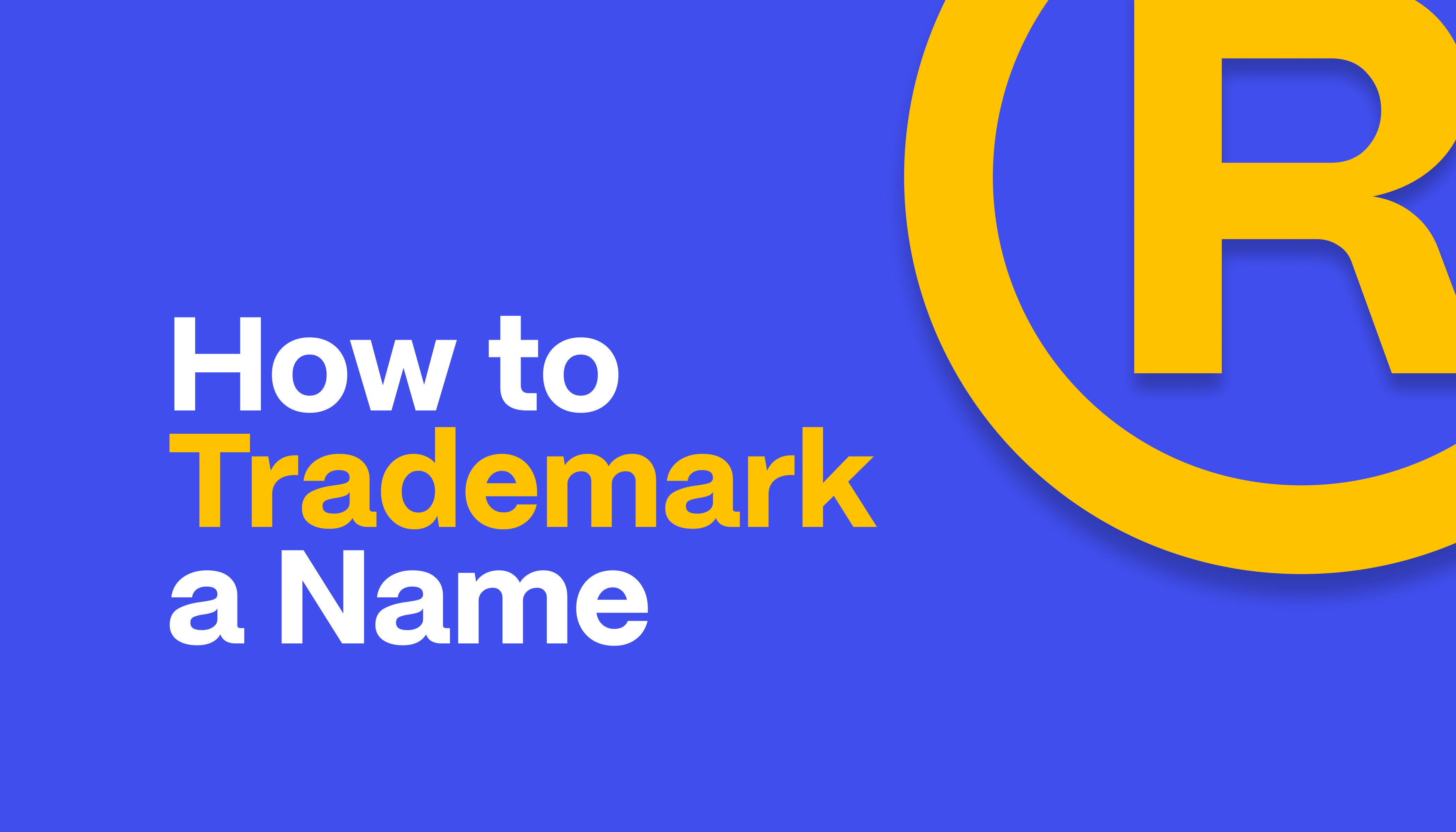How to Trademark a Name: Protecting Your Brand in 2025

Trademarking a name is an important step for protecting your brand identity, whether you’re starting a new business, product, or service. It prevents others from using a name that’s identical or confusingly similar to yours, giving you legal ownership and ensuring your brand remains exclusively yours. Beyond protection, a trademark also adds credibility, helping your business stand out in a crowded marketplace.
If you’re considering trademarking your name, it’s natural to have questions. The guide below is designed to answer them and walk you through ‘how to trademark a name’ step by step.
Table of Contents
5 Easy Steps How to Trademark a Name
Understanding the trademarking process can save you a ton of time and ultimately prevent costly mistakes. Here’s how you can trademark a name in five simple steps.
Step 1: Conduct a Trademark Search
Before you begin the application process, it’s crucial to ensure the name you want to trademark isn’t already in use. Use the U.S. Patent and Trademark Office (USPTO) database to search for existing trademarks.
- Why this step is important: Filing for a trademark on a name already registered could lead to rejection or legal complications.
- Pro tip: Consider hiring a trademark attorney to perform a comprehensive search to uncover potential conflicts that may not appear in the database.
Step 2: Determine the Type of Trademark You Need
You can file for different types of trademarks depending on what you’re protecting:
- Standard Character Format: Protects the name regardless of design or font style.
- Special Form Format: Protects the specific stylized version of your name, such as a logo.
Choose the type that best aligns with your goals.
Step 3: File Your Application with the USPTO
Once you’ve confirmed the name’s availability and type of trademark, file an application online using the USPTO’s Trademark Electronic Application System (TEAS).
- Information required:
- Name of the owner (individual or business entity).
- The goods or services associated with the trademark.
- Proof of use in commerce (if applicable).
- TEAS options: TEAS Plus (lower fee, strict requirements) or TEAS Standard (higher fee, more flexibility).
Step 4: Wait for USPTO Application Review
After submitting your application, the USPTO will review it to ensure compliance with all requirements. This process can take 6-12 months or possibly even longer.
- During this phase, an examining attorney may contact you for clarifications or additional information.
- If no issues arise, your application will proceed to publication in the USPTO’s Official Gazette.
For more information, visit LendFly.
Step 5: Respond to Office Actions and Publication
Here is what you can expect if your application is approved:
- Notice of Publication: The trademark will be published in the Official Gazette, allowing others to oppose it within 30 days.
- Final Registration: If no oppositions arise within the given time frame, your trademark will be registered, and you’ll receive a certificate of your official registration.
If you feel like you still have unanswered questions regarding the process, check out the USPTO “Trademark Process” page.
What Can You Trademark?
You can trademark names, words, logos, symbols, and even sounds that distinguish your brand. To qualify for trademark protection, your name must be unique and used in commerce. Generic or descriptive names, such as “Best Coffee Shop,” are generally not eligible unless they’ve acquired distinctiveness over time.
Trademark Limitations
While trademarks offer significant protections, they come with limitations:
- Geographic scope: U.S. trademarks are only valid within the United States.
- Industry-specific: Trademark protection applies only within the specific category of goods or services you list in your application.
- Usage requirement: You must actively use your trademark in commerce to maintain rights. (This means that you must consistently use your trademark in connection with the sale of goods or services in the marketplace. Simply owning a trademark isn’t enough to maintain your rights; you need to show that it’s being actively used in commerce. If you stop using it for an extended period (typically three years or more), your trademark could be considered “abandoned,” and you may lose your legal protection.)
The Cost of Getting a Trademark
The cost of trademarking a name varies depending on the application type and number of classes (categories of goods/services).
- USPTO filing fees:
- TEAS Plus: $250 per class.
- TEAS Standard: $350 per class.
- Attorney fees: If you hire a lawyer, expect to pay between $500 and $2,000 for their services.
- Maintenance fees: Renewals are required after 5-6 years and every 10 years thereafter.
How to Maintain Your Trademark
After successfully registering your trademark, it’s crucial to maintain it to retain your legal rights:
- Use in Commerce: Continue using your trademark in connection with the goods or services listed in your application. Prolonged non-use (typically three years or more) could lead to abandonment.
- File Maintenance Documents: Submit the required maintenance forms to the USPTO:
- Declaration of Use: Due between the 5th and 6th years after registration.
- Renewal Application: Due every 10 years to keep your trademark active.
- Monitor for Infringement: Keep an eye out for unauthorized use of your trademark and take legal action if necessary.
- Update Information: Notify the USPTO if your business address or ownership details change.
Failing to meet these requirements can result in the cancellation of your trademark. You can learn more about trademark maintenance on the USPTO site.
Reasons Why a Trademark Could Be Denied
It’s important to note that not all trademark applications will be approved. Common reasons for denial include:
- Likelihood of confusion: The name is too similar to an existing trademark in the same category.
- Descriptiveness: The name merely describes the goods or services without distinctiveness.
- Generic terms: Names that are too generic cannot be trademarked.
- Improper use: The name isn’t being used in commerce or is used inappropriately.
- Incomplete application: Missing or inaccurate information can result in rejection.
If your application happens to be denied, you can appeal to the TTAB. For more information on the appeal process, click here.
Do You Feel Ready to Apply for That Trademark?
Trademarking a name is a vital step for protecting your business and ensuring long-term brand recognition. By conducting thorough research, filing an accurate application, and maintaining compliance with USPTO requirements, you can secure exclusive rights to your name. Don’t let the process intimidate you—follow these steps to protect what you’ve worked so hard to build.
If you still are feeling unsure of the trademarking process, hiring an attorney is always a good idea. We wish you luck!
Struggling with naming your business? Check out our list of 260+ brand name ideas!
Trademark FAQs
1. How long does it take to trademark a name?
The process typically takes 6-12 months, but it could take longer if the USPTO requests additional information or if oppositions arise.
2. Can I trademark a name for free?
No, trademarking a name involves filing fees with the USPTO, starting at $250 per class for TEAS Plus applications. You can find additional information about associated trademarking fees here.
3. Do I need a lawyer to trademark a name?
No, you can file a trademark application on your own. However, hiring a trademark attorney can help ensure your application is accurate and increases your chances of approval. Learn more about this topic here.
4. How long does a trademark last?
A trademark lasts indefinitely, provided you file required maintenance documents and fees after 5-6 years and every 10 years thereafter.
5. Can I trademark a personal name?
Yes, personal names can be trademarked if they are used in commerce and have acquired distinctiveness.
6. What happens if someone opposes my trademark?
If someone opposes your trademark during the publication phase, you may need to resolve the dispute through legal proceedings or withdraw your application.
7. Can I trademark a name already in use?
If the name is already trademarked within your category of goods or services, you likely cannot trademark it. Conduct a search to confirm availability before applying.
Nichehacks Top Relevant Articles
Brand Name Ideas: Find the Perfect Name for Your Business
Discover creative and impactful brand name ideas to help your business stand out.
Outsourcing Legal Aid: A Smart Move for Small Businesses
Learn how outsourcing legal support can save time and money for your business.
30 Unique Business Ideas
Explore innovative business ideas to launch a profitable venture this year.





